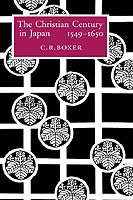Four hundred and fifty years ago, on 23 September 1543, three Portuguese merchants travelling on a Chinese junk were blown by a storm onto the south-western tip of Japan. So at last was discovered to the West that fabled country which Marco Polo reported and Columbus sought. The chief Japanese trade links were with China, but these had been severed by violent piracy at sea and along the coast. The Portuguese, with their large, well-armed carracks, revived the trade, exchanging Chinese silks and a variety of foreign exotica for Japanese silver, at immense profit. Japan was then in a state of medieval confusion. The emperors were impoverished, their sovereignty nominal; their generalissimos, the shoguns, had long proved unable to control the feudal lords, the daimyos. These were largely independent, able to let in foreigners at will. Western goods lent prestige to rival courts; some, like the musket, were useful in the constant wars. With trade came Christianity. In 1549, Francis Xavier himself established the first Jesuit mission. His hopes ran high: 'It seems to me that we shall never find among heathens another race to equal the Japanese.'
Despite difficulties of language and culture, the new religion struck root: by the end of the 'Christian Century' there were some 300,000 converts. Success bred competition. The Portuguese trading monopoly was infringed by Spaniards, English and Dutch; the Jesuit monopoly was eroded by Franciscan rivals and Protestant enemies. Whereas catholic Christian unity disintegrated, a new dynasty of Shoguns restored the unity of Japan, gradually brining the daimyos to hell. Inspired by a fierce nationalism, the new shoguns grew suspicious of foreign trade and foreign religious ambitions and feared that local Christians might act as a 'fifth column' for the West. When a peasant rebellion occurred in a Christianized province the government loosed a violent persecution: chilling refinements of torture were met with astonishing fortitude. The country was virtually closed to foreigners for 200 years. Yet Christianity somehow survived underground: after the arrival in 1853 of Commodore Perry's fleet led to the reopening of Japan, many thousands of secret Christians revealed themselves.This remarkable and little known period is the subject of Professor Charles Boxer's The Christian Century in Japan.
First published in 1951, its combination of original scholarship, lucidity and humanity have made it a classic. This edition includes illustrations of works of art produced during that brief but fruitful intercourse between Japan and the West.
EAN 9781857540352
ISBN 1857540352
Binding Hardback
Publisher Carcanet Press Ltd
Publication date September 23, 1994
Pages 552
Language English
Dimensions 235 x 158 x 37
Country United Kingdom
Readership Professional & Scholarly
Authors Boxer C. R.
Illustrations colour illustrations
Edition UK ed.
Series Aspects of Portugal

















